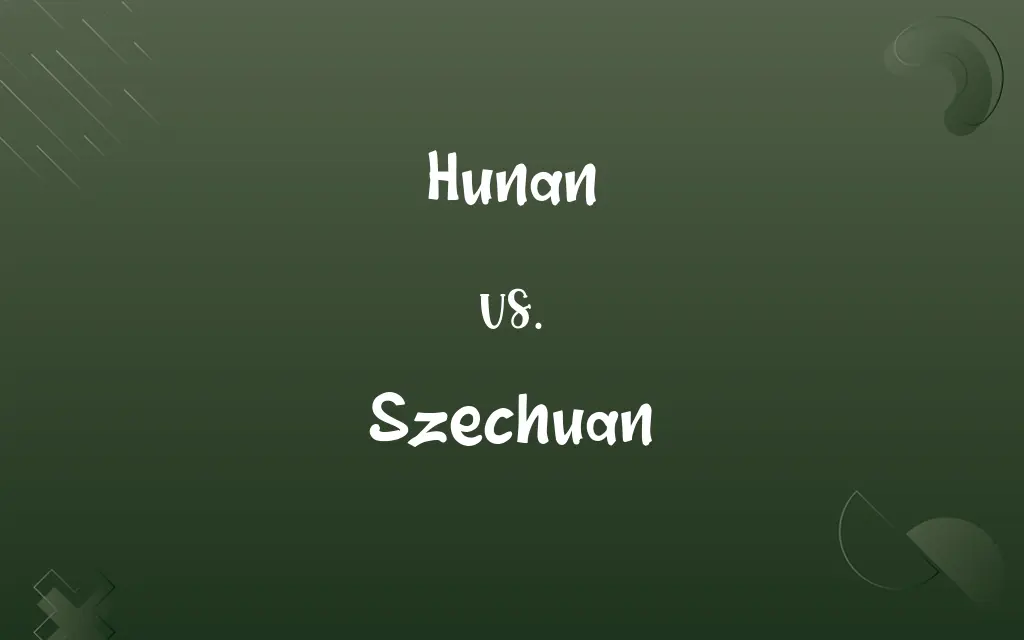Hunan vs. Szechuan: Know the Difference

By Dua Fatima & Shumaila Saeed || Published on March 3, 2024
Hunan and Szechuan cuisines are both spicy Chinese cooking styles; Hunan is known for its hot and sour flavors, while Szechuan features bold spiciness and Sichuan peppercorn.

Key Differences
Hunan and Szechuan cuisines are celebrated components of Chinese gastronomy, both renowned for their use of chili peppers and garlic, yet they differ significantly in flavor profiles and cooking techniques. Hunan cuisine, originating from the Hunan Province, emphasizes a hot and sour taste, often using fresh chili peppers, shallots, and vinegar to create a vibrant, bold flavor. In contrast, Szechuan cuisine, from Sichuan Province, is famous for its intense spiciness and the unique numbing sensation caused by Sichuan peppercorns, alongside the use of preserved ingredients that add depth.
Shumaila Saeed
Mar 03, 2024
Both cuisines enjoy a high degree of spiciness, Hunan dishes typically incorporate a greater variety of fresh ingredients, leading to a more pronounced contrast between spicy and sour tastes. Szechuan, however, often balances the heat with sweet and savory flavors, thanks to the inclusion of ingredients like sugar and hoisin sauce, creating a complex flavor profile that dances on the palate.
Shumaila Saeed
Mar 03, 2024
Hunan cooking employs a variety of cooking methods, including smoking and braising, to enhance the natural flavors of its ingredients. Szechuan cuisine, known for its bold seasoning, frequently uses techniques such as stir-frying and steaming to infuse dishes with its characteristic spicy and numbing flavors. This results in Szechuan dishes often having a more pronounced aromatic and flavorful sauce compared to the simpler, more direct heat of Hunan dishes.
Dua Fatima
Mar 03, 2024
The use of Sichuan peppercorns is a hallmark of Szechuan cuisine, imparting a unique numbing sensation that distinguishes it from other Chinese culinary traditions. Hunan cuisine, while also spicy, focuses more on the purity of chili heat without the numbing effect, resulting in a cleaner, sharper taste profile.
Hifza Nasir
Mar 03, 2024
Hunan and Szechuan cuisines are celebrated for their spiciness, they offer distinct culinary experiences. Hunan dishes showcase a harmonious blend of hot and sour, emphasizing fresh ingredients and bold, straightforward flavors. Szechuan cuisine delights with its complex interplay of spicy, sweet, and savory, marked by the iconic numbing sensation of Sichuan peppercorns.
Dua Fatima
Mar 03, 2024
ADVERTISEMENT
Comparison Chart
Flavor Profile
Hot and sour, with a focus on freshness
Bold spiciness with sweet, savory, and numbing notes
Dua Fatima
Mar 03, 2024
Key Ingredients
Fresh chili peppers, shallots, vinegar
Sichuan peppercorns, preserved ingredients
Dua Fatima
Mar 03, 2024
Spice Level
High with direct heat
High with complex flavors including numbing sensation
Dua Fatima
Mar 03, 2024
ADVERTISEMENT
Signature Aspect
Emphasis on fresh ingredients and straightforward spiciness
Use of Sichuan peppercorns for a unique numbing effect
Shumaila Saeed
Mar 03, 2024
Hunan and Szechuan Definitions
Hunan
Incorporates smoking and braising.
Smoked pork with garlic and chili exemplifies Hunan cooking.
Dua Fatima
Feb 26, 2024
Szechuan
Characterized by bold spiciness and numbing sensation.
Mapo tofu features Sichuan peppercorns for a unique taste.
Shumaila Saeed
Feb 26, 2024
Hunan
Emphasizes straightforward spiciness.
Hunan spicy chicken is a direct blast of heat.
Shumaila Saeed
Feb 26, 2024
Szechuan
Uses preserved ingredients for depth.
Szechuan pickled vegetables add complexity to dishes.
Shumaila Saeed
Feb 26, 2024
ADVERTISEMENT
Hunan
Focuses on freshness and bold flavors.
Stir-fried vegetables in Hunan style are vibrant and spicy.
Dua Fatima
Feb 26, 2024
Szechuan
Relies on Sichuan peppercorns for numbing effect.
Spicy Sichuan noodles are both hot and numbing.
Dua Fatima
Feb 26, 2024
Hunan
Known for its hot and sour flavors.
Hunan beef combines chili and vinegar for a tangy spice.
Dua Fatima
Feb 26, 2024
Szechuan
Famous for stir-frying and steaming.
Szechuan shrimp is quickly stir-fried with spices.
Hifza Nasir
Feb 26, 2024
Hunan
Utilizes fresh chili peppers.
Steamed fish with chopped fresh chilis showcases Hunan's heat.
Shumaila Saeed
Feb 26, 2024
Szechuan
Balances heat with sweet and savory.
Kung Pao chicken combines chili, sugar, and nuts.
Dua Fatima
Feb 26, 2024
Repeatedly Asked Queries
Is Hunan or Szechuan spicier?
Both can be very spicy, but the experience of spiciness differs; Hunan dishes often have a more direct heat, while Szechuan's spiciness is complex and includes a numbing sensation.
Dua Fatima
Mar 03, 2024
Can the same dish be prepared in both Hunan and Szechuan styles?
Yes, many Chinese dishes can be adapted to either style, with variations in ingredients and seasoning to fit the respective flavor profiles.
Dua Fatima
Mar 03, 2024
Why are preserved ingredients used in Szechuan cuisine?
Preserved ingredients add depth and complexity to dishes, enriching the cuisine's flavor profile with savory and sometimes sweet undertones.
Shumaila Saeed
Mar 03, 2024
What distinguishes Hunan cuisine from Szechuan?
Hunan cuisine is known for its hot and sour flavors with a focus on freshness, while Szechuan cuisine features bold spiciness balanced with sweet, savory, and a unique numbing sensation from Sichuan peppercorns.
Shumaila Saeed
Mar 03, 2024
Why does Szechuan cuisine have a numbing sensation?
The numbing sensation is due to the use of Sichuan peppercorns, a key ingredient that adds a unique characteristic to Szechuan dishes.
Shumaila Saeed
Mar 03, 2024
What makes Hunan cuisine emphasize freshness?
Hunan cuisine often uses fresh ingredients, including vegetables and meats, and minimal preservation techniques to highlight the natural tastes and textures of the ingredients.
Dua Fatima
Mar 03, 2024
What are some iconic dishes from Hunan and Szechuan cuisines?
For Hunan, dishes like steamed fish with chopped chili and smoked pork are iconic. Szechuan is known for Mapo tofu and Kung Pao chicken, among others.
Hifza Nasir
Mar 03, 2024
How does the use of chili peppers differ in Hunan and Szechuan cuisines?
Hunan cuisine uses fresh chili peppers to achieve a straightforward spiciness, while Szechuan cuisine often uses both fresh and dried chilis, along with Sichuan peppercorns, for a layered flavor profile.
Shumaila Saeed
Mar 03, 2024
How do cooking techniques differ between Hunan and Szechuan cuisines?
Hunan cuisine employs a variety of methods like smoking and braising to enhance natural flavors, while Szechuan cuisine favors techniques like stir-frying and steaming to infuse dishes with spicy and aromatic flavors.
Shumaila Saeed
Mar 03, 2024
How should one choose between Hunan and Szechuan cuisine?
The choice depends on personal taste preferences; if you enjoy pure, direct heat and freshness, opt for Hunan. If you prefer complex flavors with a spicy, sweet, and numbing sensation, choose Szechuan.
Dua Fatima
Mar 03, 2024
Are Hunan and Szechuan cuisines popular outside of China?
Yes, both cuisines have gained international popularity, featured in Chinese restaurants worldwide, appealing to those who enjoy spicy foods.
Shumaila Saeed
Mar 03, 2024
Share this page
Link for your blog / website
HTML
Link to share via messenger
About Author
Written by
Dua FatimaCo-written by
Shumaila SaeedShumaila Saeed, an expert content creator with 6 years of experience, specializes in distilling complex topics into easily digestible comparisons, shining a light on the nuances that both inform and educate readers with clarity and accuracy.








































































